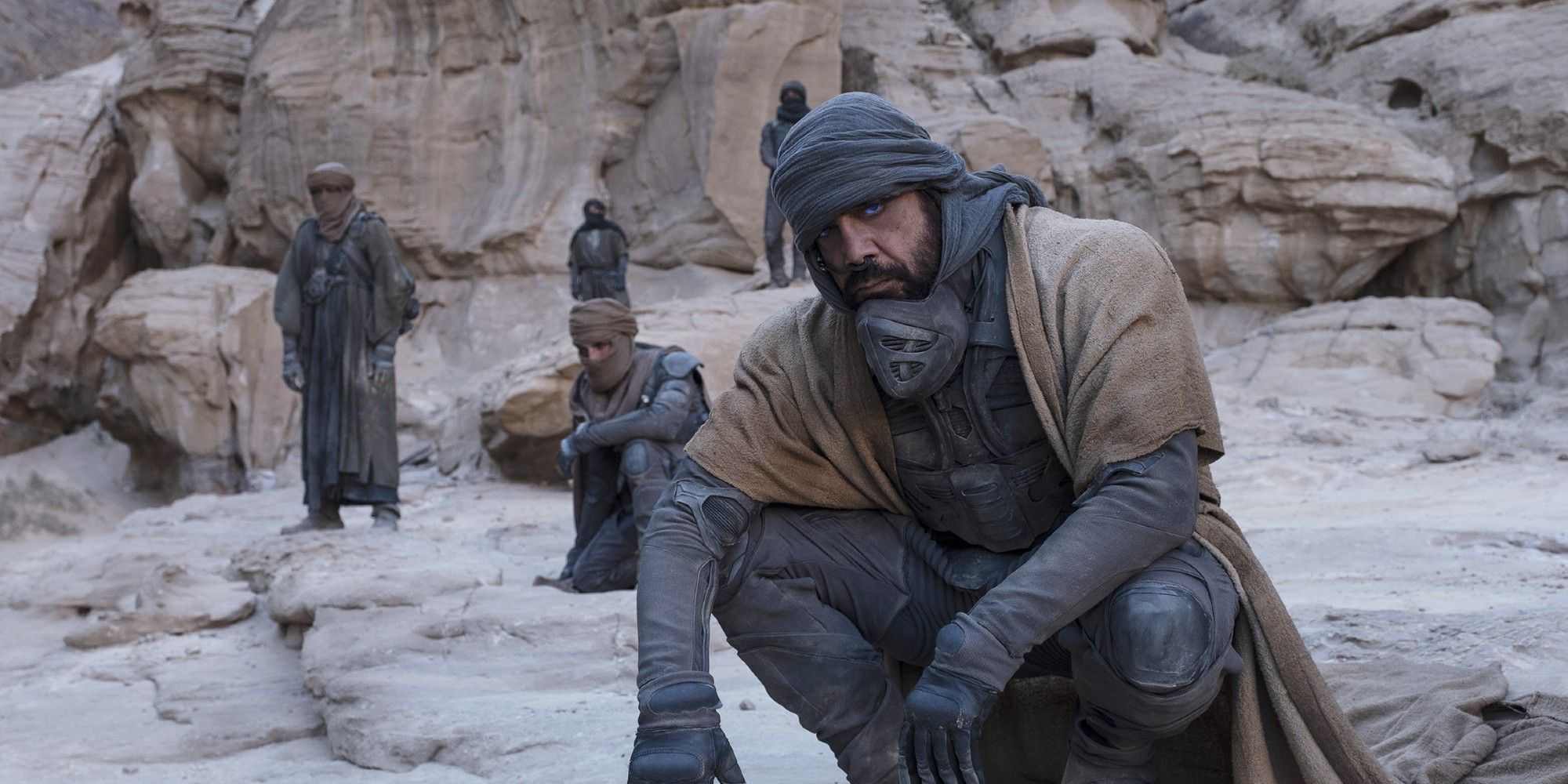The Big Picture
- While it is commonly understood that Earth is gone in the Dune universe, no one can say exactly what happened to the planet.
- Though Earth's fate in Dune remains a mystery, remnants of Earth still live on Frank Herbert's Dune.
- It will be interesting to see if Denis Villeneuve tackles the history of Earth in upcoming sequels.
Denis Villeneuve's 2021 film adaptation of Frank Herbert's epic science fiction saga, Dune, took audiences to multiple expansive planets in the intriguing fictional universe, including Caladan, Giedi Prime, and Arrakis. Viewers followed the noble family of House Atreides on their new venture from their water-planet, Caladan, to the desert-planet of Arrakis, where they had been ordered by the Imperium to take over the spice-mining operations.
Up until then, House Harkonnen, from the planet Giedi Prime and feudal rivals to the Atreides, had overseen the spice-mining. Unsurprising, as part of the plot by the envious Emperor, the Harkonnens refused to let go of the planet without a fight. Thus, setting the events and build-up of the first film of this epic saga in motion. With all of these visually-stunning planets that we visit in the film, you might wonder if any of them used to be Earth. Now with Dune: Part Two around the corner, that question might be more prevalent than ever. The short answer? It's hard to say exactly what happened to Earth, but, we do have some clues from the Dune 'universe' of novels, film, and other media, which may help answer some questions.

Dune
A noble family becomes embroiled in a war for control over the galaxy's most valuable asset while its heir becomes troubled by visions of a dark future.
- Release Date
- October 22, 2021
- Director
- Denis Villeneuve
- Cast
- Rebecca Ferguson , Zendaya Coleman , Jason Momoa , Timothee Chalamet , Josh Brolin , David Dastmalchian
- Runtime
- 155 Minutes
- Main Genre
- Sci-Fi
- Writers
- Frank Herbert , Eric Roth , Denis Villeneuve , Jon Spaihts
- Studio
- Paramount Pictures
- Tagline
- A mythic and emotionally charged hero’s journey
Earth Has a Complicated History in Frank Herbert's 'Dune' Universe
Herbert's original Dune saga spans six novels and thousands of years, and concludes with Dune: Chapterhouse. However, following Herbert's death in 1986, the Dune universe was continued by his son, Brian Herbert, who has written additional novels for the saga with the help of others who were also close to Herbert. The continued Dune universe now includes more than 20 novels, and offers expanded details and explanations from Frank Herbert's original six books.
Additionally, The Dune Encyclopedia, published just before Herbert's death, serves as a reference text for the novels, as it's compiled of articles and essays by 43 different contributors. However, in all of this additional work, what's considered 'canon' by fans — including what happened to Earth — depends on who you ask and which texts you follow. Here's what happened to Earth, based on what we can gather from the Dune "universe" of material. A little more than 10,000 years before the events of Dune, Earth underwent a drastic change, due to what's called the Butlerian Jihad. Like the battles that we witness Paul Atreides (Timothée Chalamet) having visions of in Villeneuve's film, this "jihad" on Earth was a violent, religious crusade between man and machine, as the inorganic artificial intelligence had posed an existential threat against humankind.
Now, in this post-Butlerian jihad universe, any sort of "thinking machines," or intelligence of the computer-generated kind, are forbidden to exist. This is why we don't see anything resembling a computer in Villeneuve's film. This is also the reasoning behind the development of biological super-computers — humans known as "mentats" — like Thufir Hawat (Stephen McKinley Henderson) and Piter de Vries (David Dastmalchian). Following the Butlerian Jihad, a group of translators converged on Earth to create the Orange Catholic Bible, which we witness Gurney Halleck (Josh Brolin) reading from and quoting, often.
Remnants of Earth Exist Throughout the 'Dune' Universe
The interesting thing about the Dune universe is that all the Space Guild inhabitants originate from Earth. There aren't any "space aliens" like you might expect from an intergalactic sci-fi epic like Dune. For the people spread among the various planets of Dune's solar system, Earth is the cradle of civilization. Earth is the ancestral home of the people of Caladan, Giedi Prime, Arrakis, and the rest. As such, the Imperium appears and operates in a fashion similar to the feudal systems of the Earth that we, the audience, recognize.

Where Was ‘Dune’ Filmed? Here's Where You'll Find the Deserts of Arrakis on Earth
We gotta know where to avoid the sandworms!In fact, House Atreides can track their lineage all the way back to Agamemnon — the historically famous ruler of Ancient Greece. In fact, Agamemnon is referenced in the movie when Duke Leto (Oscar Isaac) thoughtfully gazes at a figure on golden tablets before leaving Caladan. In addition to the Atreides claiming the bloodline of Agamemnon, we also get glimpses in the first book of an Earth we recognize, from Paul Atreides. Paul refers to the power of ancient figures such as Ghengis Khan, when he warns of the catastrophic danger that accompanies political leadership.
Later in the saga, Leto II, who is capable of the Bene Gesserit skill of exploring all the memories of his ancestors, will often spend lots of time reliving historically recognizable events from Earth. Leto II is able to remember Roman invasions, the music of Bach and Mozart, the battles of Napoleon, and more, all from the Earth that we know. Additionally, various languages from Earth are spoken in secret, plants that were native to Earth are cultivated, and hybrid animals based on Earth's species are bred on distant planets, throughout the Dune universe and over thousands of years.
What Exactly Happened to Earth in 'Dune'?
Dune is set in 10,191 A.G. (After Guild), as we see in the first scene in Villeneuve's film. "After Guild" refers to the period after the establishment of the Space Guild that the Atreides and other feudal houses live within, which was created with the colonization of the known universe. According to The Dune Encyclopedia, thousands of years after the solar system had been colonized by humans and then controlled by the Guild, Earth was hit by another "planetoid" and nearly destroyed. At the time, the inhabitants of the rest of the solar system outnumbered the people of Earth, twenty to one. So, the Imperial seat was moved from Earth and a rescue mission of artifacts was conducted. A few decades later, Earth was reseeded and set aside as a National Park, by order of the Imperium. From there, things get complicated. For Dune fans, a lot of inconsistencies occur between the explanations provided by The Dune Encyclopedia and the additional Dune novels written by Frank Herbert's son, Brian.
Luckily, we can look to the source material for more details. In conversations held by the Bene Gesserit in the original Frank Herbert novels, we learn that the secret order of women retain a few lost artifacts from what they refer to as "Old Earth" or "Old Terra," including a painting by Vincent Van Gogh. Additionally, Leto II says in the fourth novel of the saga that Earth no longer exists. By the time of Frank Herbert's sixth and final Dune novel, Chapterhouse, which takes place several thousands of years after the time of Paul Atreides, the Bene Gesserit refer to Earth as simply being "gone." Again, it's a bit of a mystery — what exactly happened to Earth and why its gone — according to the Dune universe of material. However, it will be interesting to see if, and how, Denis Villeneuve fills in the blank spaces of Earth's history in Dune: Part Two.
Dune is now available to stream on Netflix and Max in the U.S.


